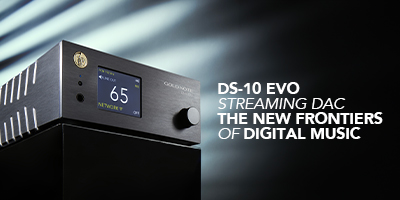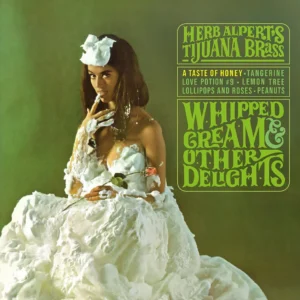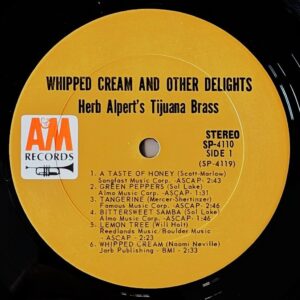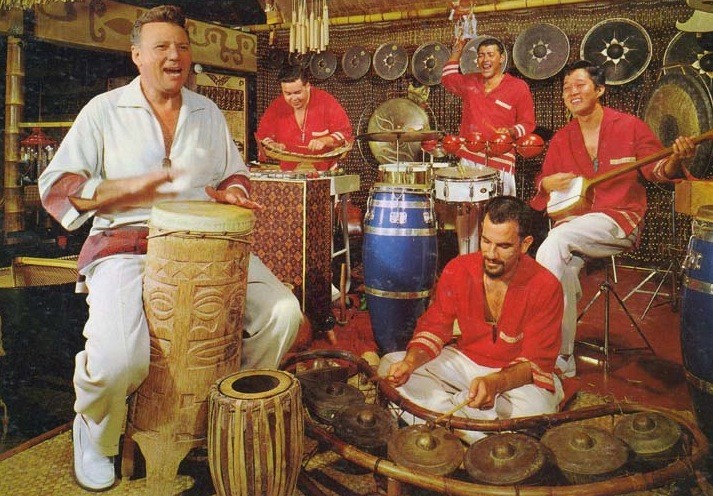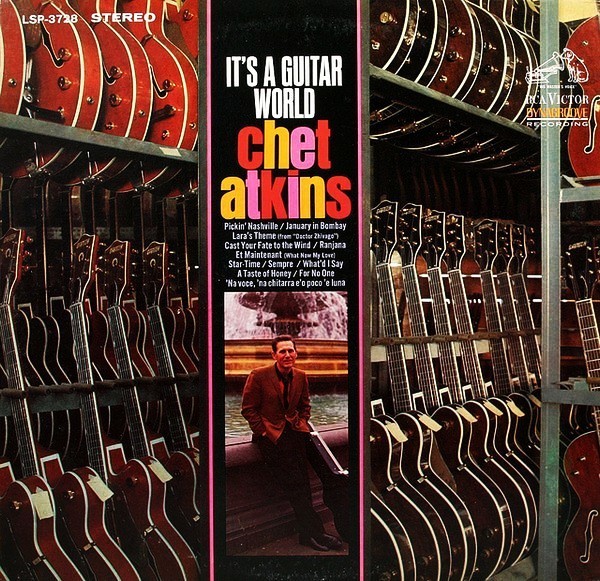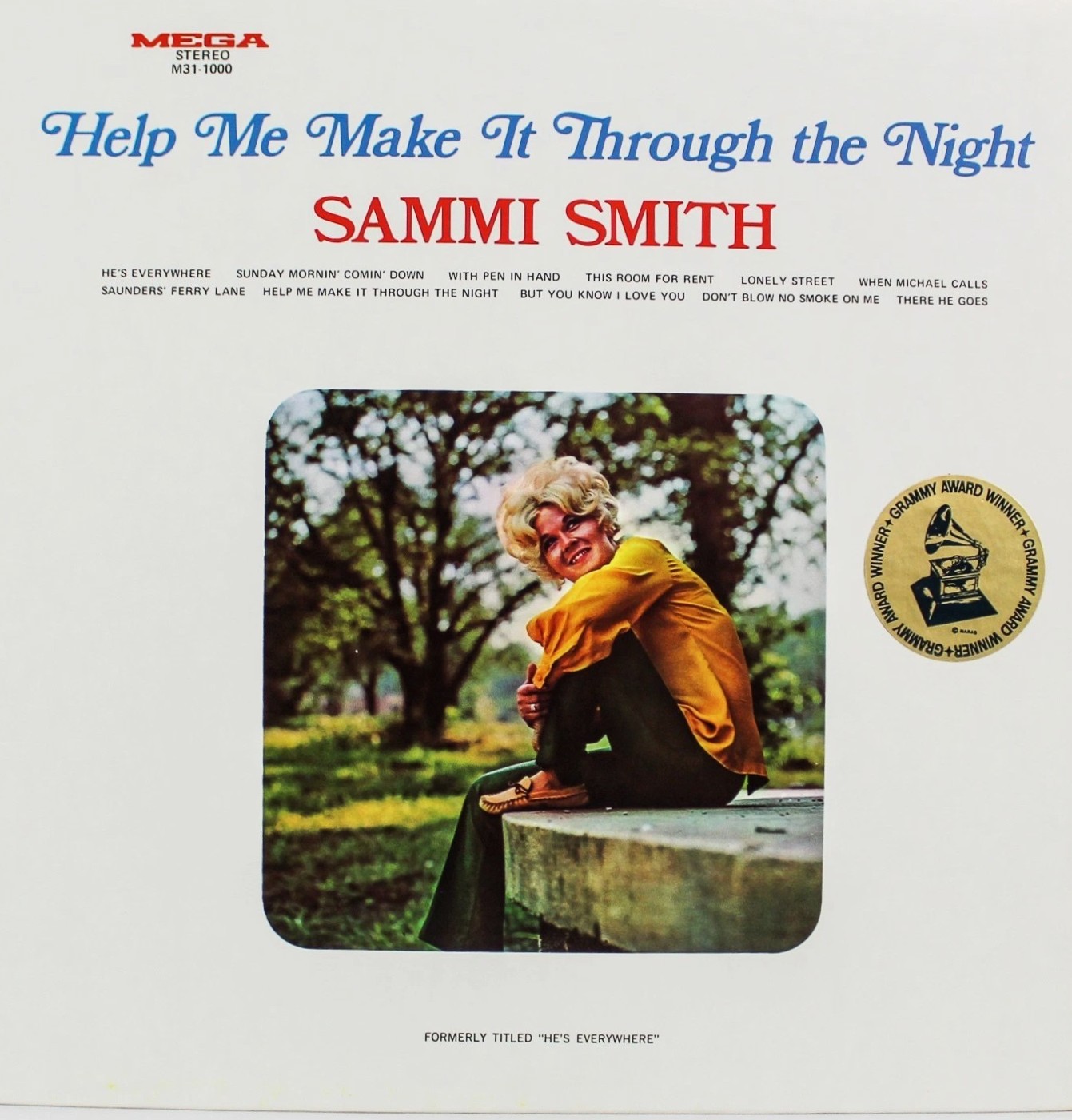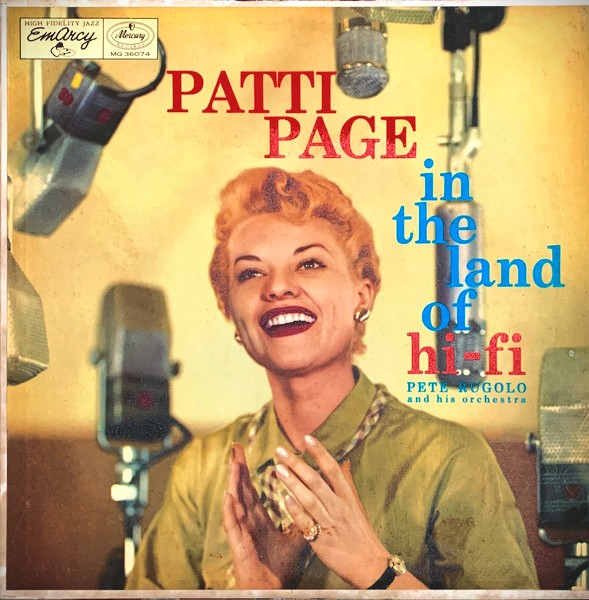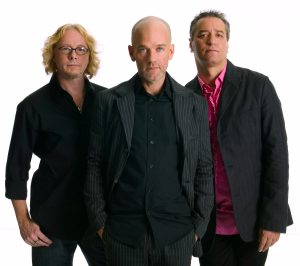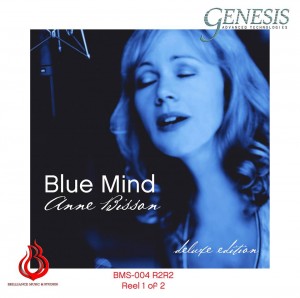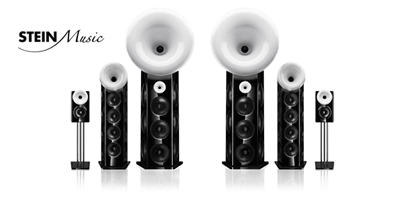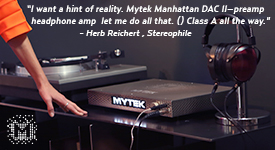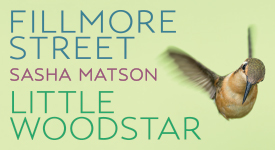Selecting an album which inspires me enough to write about it isn't easy. A lot of thoughts go through my mind, such as: Should I avoid an album because it's hard to find? Should I avoid an artist that few have heard of? And should I avoid an album if the sound quality is less than excellent? Up until now, I've avoided albums that are really famous, because I don't want to repeat what others have already said. However, this time I chose one, and I did it because I love the album, and, second, because I'm pretty darn sure that most Positive Feedback readers have never heard a smokin' hot copy of Herb Alpert's Whipped Cream & Other Delights (A&M SP4110) on a smokin' hot audio system.
Whipped Cream & Other Delights, released in 1965, is the fourth album by Herb Alpert and The Tijuana Brass. Every cut on this album was intended to be a food title, and all but one is. This idea was conceived by A&M Records' cofounder, Jerry Moss (1935-2023). And who was the Tijuana Brass? They were all members of the famous Wrecking Crew. However, after the album's enormous success, Alpert wanted to concertize, so he created a touring version of TheTijuana Brass. They subsequently joined Alpert on his recordings.
In my teens I wouldn't admit that I enjoyed Alpert. And that's because he didn't strike me as cool. To be more specific, his music was a guilty pleasure because he looked like a square celebrity: the kind my parents watched on TV after I went to bed. In other words, he was Engelbert Humperdink with a horn: a musician who didn't rock. My idea of cool was The Beatles, The Rolling Stones, Bob Dylan, and The Byrds. Today I realize just how cool Alpert, his music, and his record label really were. Frankly, I really do prefer pop music with vocals, and Alpert's music was uniquely lacking vocals. However, that didn't stop him from being just as successful as the rock bands who sang. And then there was his Mexican-flavored brass. That wasn't exactly cool to me either. And yet, despite my childish views, I eventually grew to appreciate his first four albums.
Before I get to today's subject, it's worth noting that Alpert played all of the trumpet parts on his albums from the sixties. A master of playing along with himself, his overdubbed sound can be placed under the same umbrella as Les Paul and Mary Ford, David Seville and the Chipmunks, The Carpenters, and Queen.
Whipped Cream & Other Delights was recorded between 1964 and 1965 at Goldstar Studios in Los Angeles, and it was released in April, 1965. As recordings from this era were only made with tube gear, the album's sound is rich and the musical colors are fully saturated. It's a sound that many LP-loving audiophiles, myself included, love.
The opening cut is the smash hit "A Taste of Honey," which in my opinion is Alpert's finest moment. Despite the fact that I've been hearing it for sixty years, it always sounds like it could have been created yesterday. The term "timeless classic" aptly applies. And no other cut on this album has better sound quality. Although I must have heard it a thousand times, nothing beats the way I hear it now, with my Audio Research-driven Legacy speakers. My audio system has a particular affection for ol' Herb. But beware, my fellow vinyl addicts, random copies of this album sound smeared and sour.
"A Taste of Honey" opens softly with Alpert's hushed double-tracked trumpet on the right. And sitting right next to him, in the right hand corner, is Julius Wechter's marimba. At the same time John Pisano slowly picks an electric guitar on the left. But soon a big event is about to occur, and that event is the pounding of Hal Blaine's fully ripened kick drum. Originally intended as nothing more than a not-to-be-heard-by-the-public metronome, Blaine's big fat RCA ribbon-mic'd drum has become the song's most enduring trademark. But not to be outdone by Blaine's kick drum (and his amazingly perfect shuffle work) is Alpert's magnificent trumpet playing in the song's main theme. However, right before we hear the trumpet we hear Bob Edmonson's blaring trombone. (It jumps out of my right speaker like a torpedo!) Like the album's sexy cover photo, "A Taste of Honey" stimulated everybody who came in contact with it. It also showed another side of Alpert, who, up until this point, had made his living playing Mexican-flavored power-fluff. And then there's the song's unusual structure. As a child, I was fascinated by its cyclic sound. It starts slow and quiet, then it's loud and fast, and then it's slow and quiet again, only to become fast and loud again. And then there's the shaking of a maraca which only adds to the unfolding magic. It also pushes the music moving forward in an insanely attractive way. The maraca emanates from the left of the soundstage, sounding as if it were inside Blaine's drum booth. (I doubt he was even in a booth.) This pianist was the incomparable Leon Russell, and he's heard coming in and out of the recording, but mostly near the song's finale. Although many have recorded vocal versions of the song, including Bobby Darin, Peggy Lee, Barbra Streisand, and even The Beatles, the song is to me sappy. What Alpert did by removing the vocals, boosting the tempo, and giving it a firm kick in the rear, is miraculous. No other version comes close to the power of his masterpiece.
The second cut is "Green Peppers." It's one of the tastier cuts on this food-themed album. It also harkens back to Alpert's earlier work, as it offers what sounds to me like a genuine taste of Mexico. Although brass is the prominent feature, I'm hooked on Pisano's inspired acoustic guitar playing, which appears on the right side of the soundstage. He's so connected with the music, and so is Blaine with his tasty rim shots on the left. Wechter's shimmering marimba shares the right side with the guitar. For some reason, the sound doesn't match the other cuts. It's not bad, but I wouldn't demo my stereo with it. It sounds like an earlier session, perhaps a year earlier. Alpert's trumpet is double-tracked and coming out of the middle.
Here's a confession: I didn't learn "Green Peppers" from Alpert. I learned it from guitar legend Wes Montomery. It's on my favorite Montgomery album, California Dreaming (Verve V6-8672) from 1967. I might have gone years without knowing that it was an Alpert tune, one that he composed with his collaborator, Sol Lake, had it not been for my friend and mastering guru, Kevin Gray. The story is simple. Kevin and I were cutting Cisco Music's 180 gram reissue of California Dreaming, and when "Green Peppers" came over the monitors, Kevin said, "That's a Herb Alpert tune." I was stunned. Herb Alpert?? No bleepin' way. That evening, I reached for the whipped (actually shaving) cream lady, and there it was. It's taken me years to hear it in my mind as an Alpert tune, rather than a Montgomery tune. Who's better? Montgomery is better, because he does more with it than Alpert. He adds improvisational jazz twists that take it to a higher place. He also benefited from Den Sebesky's incredible big band arranging, and Herbie Hancock's piano. If Alpert is an appetizer, then Montgomery is an entree. And isn't it interesting that by 1968 Montgomery was recording for A&M?
Cut four is "Bittersweet Samba" and the star is Hal Blaine. It's amazing just how destructive this one minute and forty three second cut is! Blaine is pounding my walls off and because of him I need to find more walls! Pisano is ripping the strings off his acoustic guitar and Wechter is hammering his marimba as if his life depends on it. The sound is better than the previous cut, but it's still not up to the opening cut. However, Blaine's drums, especially his kick drum, pack a fat wallop. If his drums aren't moving some serious air in your house, then maybe single-ended amplification isn't for you.
Cut five is "Lemon Tree." The opening is trippy, but then it's nothing more than sleepy. If you need a dose of this song, like I occasionally do, the place to find it is Peter, Paul, and Mary's debut album. I highly recommend the ORG's 45/2-LP set reissue (ORG 069), because it's sonically a mind-blower.
Cut six takes us to New Orleans. It's a cover of Allen Toussaint's "Whipped Cream." It's essentially a carbon copy of the original, right down to the timing of 2:33! There are two minor differences. First, Blaine was a better drummer than Aldo Venarri, and second, Alpert relied on some subtle double-tracking of his horn, which the original, recorded on a tighter budget, did not use or need. Oklahoma-born Russel was firmly in his element on the piano. This is a case of a southern boy who understands old school southern riffs. Although I grew up hearing "Whipped Cream" on the radio, I remember it best from watching The Dating Game. It was the bubbly theme used to introduce the bachelorette to the audience. This irresistible morsel features a syncopated beat; something that's uniquely typical of New Orleans-based rhythm and blues. It sounds as if its only reason for existence was to make people happy, and it does that job very well.
Side two opens with "Love Potion No. 9," which I find an odd choice for a brassy instrumental. However, I like the way Alpert slowed down the tempo, turning the rock ‘n' roll classic into a mid-tempo blues. The problem for me is he was onto something interesting, but rather quickly he turned it into something silly. Where was Don Sebesky when he was really needed?
Cut two is an original by Alpert's composing partner Sol Lake. It's called "El Garbanzo." Who doesn't love chickpeas? As a kid, I used to eat them right out of the can, and a good salad bar needs to have them. Add romaine, beets, crumbled bleu cheese, red cabbage, red onions, bacon bits, and some mashed hard-boiled eggs, and call me for lunch. I also love freshly made humus, but I digress. This album is, as mentioned, a food-themed album, and "El Garbanzo" is tasty from its beginning to its two minute and eighteen seconds end. It's also very well recorded. The left-center-right imaging, typical of old school three-channel recordings, is clear for all to hear. Drums and maraca are on the left, trumpet is in the middle, and acoustic guitar is on the right. The right side of the soundstage also contains festive shouts, and a chorus of unidentified winds. I think I hear an alto sax, a trombone, and a kazoo, but don't hold me to that. The funny thing about Alpert's version of Mexican music is the more you hear it the more authentic it sounds. As I write, this cut is playing through my Sherwood S-7650-driven Sennheiser HD650s, and Blains's magnificent drums are kicking the side of my head. He was so damn good. And this, dear friends, is what owning audio gear is all about.
Cut three is "Lady Fingers." I wish the entire cut were as good as the opening. Wechter was a great mallet man, and his vibes tone is ravishing, but then comes Alpert's horn, and nothing engaging happens after that. The easy listening is just too easy for me.
Cut four, "Butterball," is a turkey. I'm moving on.
Cut five is "Peanuts." It's a cover of a Mexican polka by the Tejano band The Sunglows from Palacio, Texas. It's also a near carbon copy of it. When I lived in Oxnard, California, I heard this kind of music frequently. I fondly remember the experience of hearing a live Mexican brass band coming from my next door neighbor's backyard. If only an audio system could recreate that kind of effortless magic was my primary thought. Alpert's participation on this cut is minimal, and in my opinion, he should have sat this one out. This is also the only cut where I noticed a tuba. And the tuba guy on the right is farting up a lovely storm. I'd love to get my hands on the raw master tape, meaning before reverb and Alpert's overdubbed trumpet were added. Then I could hear, after all of these years, if my audio system can reproduce a sound that lives inside my head.
Cut six is a killer. It's a complete transformation of the sappy song "Lollipops and Roses," and it competes with "A Taste of Honey" for the best cut on the album designation. It's impossible to play it too loud, and that's because it sounds so damn good! And the feeling of movement that it conveys is amazing! If music were a sportscar, it would be this cut. Blaine, Alpert, Russell, Wechter, and somebody I've failed to mention, bass legend Carol Kaye, are playing their hearts out. And Edmonson's trombone is back. Leon must have shared with him one of his hand-rolled south-of-the-border smokes, because on this cut he slides into a wonderful solo. If only it were longer. The maraca guy also came back. It's a great close to an evening spent with the great Herb Alpert.
The sound, as I've elaborated, of this album varies from cut to cut, but overall it's excellent, and three cuts sound incredible. The best source is a good copy of the LP. When the album was first released, the sound, at least based on the copies I've tried, wasn't as good as the first run of re-cuts, which were pressed in the early 70s. Also, I'm not sure how long A&M issued it with the tan labels, as many were printed. Between Alpert, Sergio Mendes, The Sandpipers, Cat Stevens, and The Carpenters, I've become a connoisseur of early A&M pressings, and early A&M sound. Regarding my audio system, and its interaction with this record, this title deserves the best gear you own. Although I love my vintage Sherwood receiver, and my Denon DL160 and Hana EH high output moving coils, this LP is served best by low output moving coils and the phono section of my EAR 864 tube preamp. I've achieved great results playing it with a Dynavector 17D, a Denon 103SL, and my tonearm's current resident, a highly modified Denon 103R by Paradox Pulse. There may be a high output moving coil, a fancy-tipped moving magnet, or an inexpensive sleeper cartridge that would impress me just as much. I just haven't heard one. For the sake of convenience, since I do my writing in my office, I also played the CD. Like the LP, it was mastered by Bernie Grundman. The CD was not denoised, and it's tonally identical to the LP. However, it has some peak limiting that was done in the digital domain. You can hear it, now and then, on the drums. It's sad that we are living in an era where the music industry forces even the best engineers to digitally compress their work. Their mentality is "heaven forbid if a person should feel the need to raise the volume for a particular cut." Frankly, if I didn't own four killer copies of this title, I'd never know what's missing on the CD. My guess is streaming this album wouldn't sound any different than listening to the CD. I hope I'm wrong.
Lastly, I wanted to write about the lovely Doloris Erickson who posed for what has become one of the most iconic album jackets ever created. However, I wouldn't be able to tell her story half as well as Matt Williamson can. HERE is Matt's video on the album jacket. I've learned a lot from Matt, and I love his Pop Goes the 60s YouTube channel.

